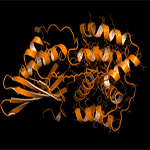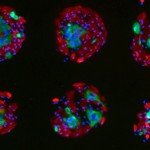Using physical chemistry methods to look at biology at the nanoscale, faculty scientist Ke Xu has invented a new technology to image single molecules with unprecedented spectral and spatial resolution, enabling new ways to examine cell structures and study diseases like Alzheimer’s.
Unlocking the Rice Immune System
Pam Ronald, a member of the Biological Systems & Engineering Division who directs JBEI’s Grass Genetics program, led a study that identified a bacterial signaling molecule that triggers an immunity response in rice plants, enabling the plants to resist a devastating blight disease.
Orange is the New Red
Cheryl Kerfeld of the Molecular Biophysics & Integrated Bioimaging (MBIB) Division led the discovery that a photo-protective mechanism in cyanobacteria is triggered by an unprecedented, large-scale movement from one location to another of the carotenoid pigment within the Orange Carotenoid Protein.
Innovative Microvi Bio-ethanol Technology Validated at Berkeley Lab
Microvi Biotechnologies, a leading innovator of biocatalytic processes, working with the Advanced Biofuels Process Demonstration Unit (ABPDU) at the Lawrence Berkeley National Laboratory (Berkeley Lab), has demonstrated breakthrough improvements to biological ethanol production.
Berkeley Lab Scientists to Develop Better Way to Screen Chemicals for Cancer-Causing Effects
The vast majority of the thousands of chemicals in our homes and workplaces have not been tested to determine if they cause cancer due to limitations in current testing methods. Berkeley Lab scientists are developing a cell culture that better identifies chemicals that increase breast cancer susceptibility.
- « Previous Page
- 1
- …
- 207
- 208
- 209
- 210
- 211
- …
- 213
- Next Page »
Was this page useful?








